Will AI Redefine the Role of Teacher?
As artificial intelligence rapidly integrates into our daily lives, its influence in education is expanding at an unprecedented rate. From automated grading systems to personalized learning tools, AI is reshaping classrooms and the way students engage with learning. But with this technological shift comes a pressing question: Will AI redefine the role of teacher? While some envision AI as a powerful assistant that enhances the teacher’s role, others wonder if it could eventually replace certain aspects of teaching altogether. This article will explore the current and potential impact of AI on teaching roles, examining how AI might complement, challenge, or even transform the responsibilities of educators in the future.
Table of contents:
- Current role of teacher
- AI in Education today
- Potential changes to the teacher’s role
- The Teacher’s evolving role
Before taking a closer look at the article content, you can experience the presentation with the same topic created by an AI-powered presentation maker – uPresenter
Current Role of Teacher
The role of teachers today extends far beyond delivering lessons. Teachers are responsible for various tasks, including instruction, assessment, mentorship, and classroom management. In the classroom, they guide students through complex topics, adapting their teaching styles to meet diverse learning needs and ensuring each student has a solid foundation of understanding. Teachers also assess students’ progress, offering constructive feedback and adjusting their approach to help each learner succeed. Beyond academics, teachers act as mentors, offering guidance on personal growth, social skills, and future aspirations. Their influence is crucial, as they shape students’ academic achievements and confidence, resilience, and curiosity – traits that last well beyond the classroom.
AI in Current Education
AI significantly impacts education through applications like personalized learning platforms, automated grading systems, and virtual tutors. These tools enhance efficiency, offer tailored learning experiences, and make education more accessible to diverse groups of students. In the previous article, we discussed the benefits, drawbacks, and real-world case studies of AI in education. Please refer to that post for a more detailed look.
Potential Changes to the Role of Teacher
As such, AI brings many benefits to education, in general, and to the teacher, in particular. So, which tasks that AI can change the roles of the teacher?
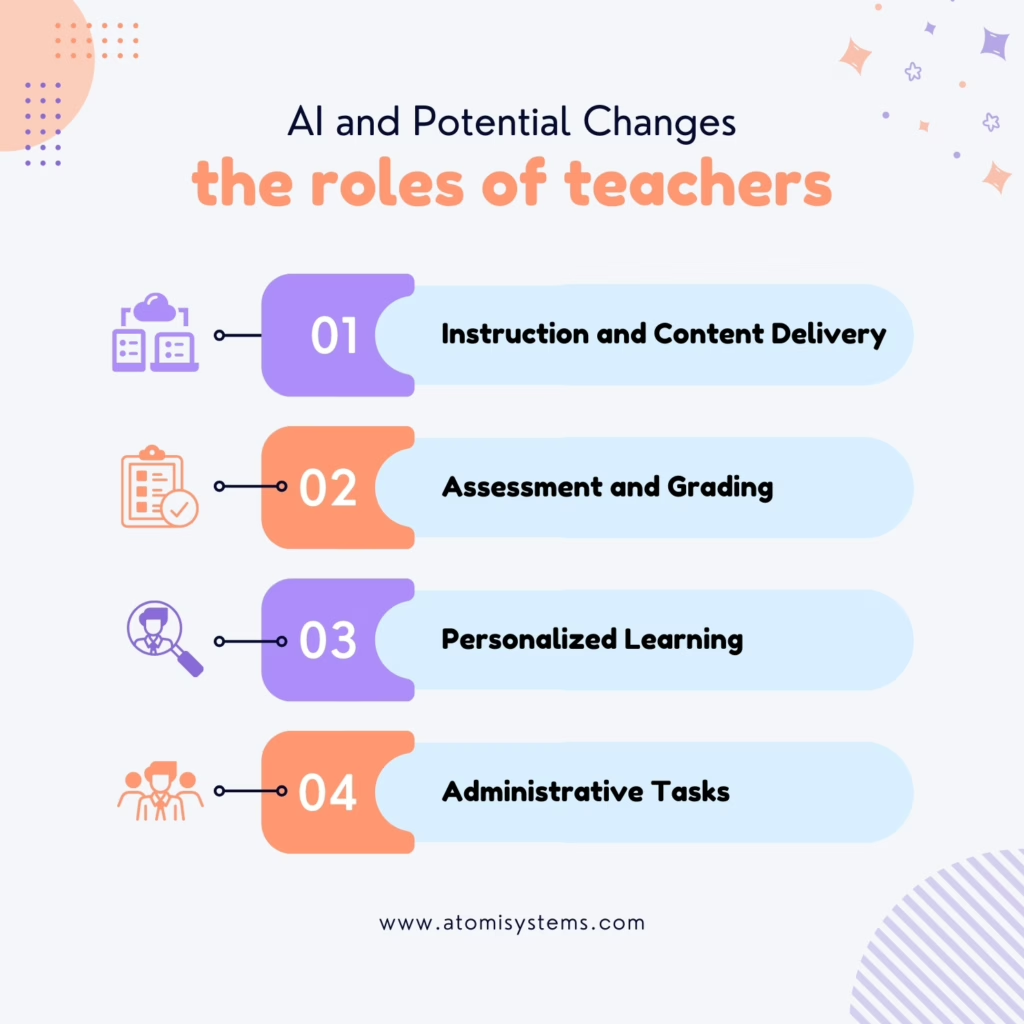
#1. Instruction and Content Delivery
AI could change how teachers deliver content, making instruction more efficient. With AI tools to provide lessons, teachers could spend less time lecturing and more time engaging students in deeper discussions. This shift would allow teachers to focus on enhancing students’ understanding rather than just delivering information.
#2. Assessment and Grading
AI may also impact assessment and grading. Automated systems can handle quizzes and even essay grading, saving teachers time. As a result, teachers could focus more on giving personalized feedback and support where needed most.
#3. Personalized Learning
In addition, AI supports personalized learning paths tailored to each student’s pace and needs. Teachers would act as guides, using AI insights to support students through specific challenges. This could lead to more engaged and independent learners.
#4. Administrative Tasks
Finally, AI can manage many administrative tasks, like tracking attendance and scheduling. By automating these routines, teachers would have more time to connect with students, fostering relationships and focusing on growth.
The Teacher’s Roles Cannot Be Replicated
As AI transforms education, teachers’ roles are evolving to focus more on facilitation and mentorship. Rather than simply delivering content, teachers guide students through personalized learning journeys, helping them apply knowledge and think critically. Importantly, teachers provide emotional and social support that AI cannot replicate, building connections and offering empathy that helps students navigate personal challenges. The human touch in education is irreplaceable – teachers bring understanding, inspiration, and encouragement, essential for fostering students’ confidence and resilience.

In these ways, teachers remain vital to the learning experience, ensuring that education is effective and deeply human.
Last Words
In summary, while AI has the potential to change aspects of teaching – such as instruction, assessment, and administrative tasks – teachers remain essential as mentors and guides. Looking to the future, the role of teachers will likely adapt alongside AI, emphasizing human connection and personalized support. For education to truly benefit from AI, collaboration between educators, policymakers, and technologists is crucial. Together, we can shape an AI-enhanced learning environment that empowers both teachers and students.
Follow our Twitter/X page and YouTube channel for more updates!
See more:
Best-picked Popular AI Tools for Teachers
AI in eLearning: Which Tool Will Speed Up Your Process?
AI Tool for Presentations: Multiple Ways to Visualize Content in uPresenter
Making great presentations often depends on how well you can show your ideas, making complicated concepts simpler and more interesting for your audience. Enter uPresenter, an AI tool for presentations and quizzes that simplifies this process through automation and smart design features. With its ability to generate infographics and multimedia elements with minimal input, uPresenter empowers users to craft professional presentations effortlessly. In this post, we’ll explore the multiple ways uPresenter helps you visualize content, transforming your presentations from ordinary to exceptional with the power of AI.
#1. Show Content by Text with Media
uPresenter makes it easy to combine text with media in a single slide, enhancing how content is visualized and delivered. Using AI-driven design capabilities, uPresenter automatically formats text alongside images, videos, or graphics, ensuring a balanced and visually appealing layout. This integration allows users to present their message more effectively, as the combination of text and media helps engage the audience and clarify key points. Whether embedding a video demonstration from your computer or YouTube video links next to explanatory text or placing an image beside a list of facts, uPresenter seamlessly merges content and visuals to create more dynamic and actual presentations.
Slides are generated automatically with uPresenter – an AI tool for presentations
#2. Present Ideas in Infographic Form
If text-heavy slides tend to bore you, uPresenter helps you present ideas in captivating infographic formats, simplifying the presentation of complex information visually appealingly. With its AI-powered design capabilities, uPresenter arranges data, text, and visuals into neatly structured infographics that emphasize key points instantly. This feature is particularly effective for condensing large volumes of information, displaying connections between ideas, or representing trends and statistics. By turning content into easily digestible visuals, this AI tool for presentations ensures that your message remains both clear and memorable, keeping your audience focused and engaged.

Besides, you can customize the look of each part in the infographic to fit your design ideas.
#3. Enhance Interactivity with Quiz Slides
An AI tool for presentations can create quiz slides. Many other tools don’t but uPresenter does.
uPresenter elevates presentations by automatically creating interactive quiz slides, bringing a lively, engaging aspect to your content. Leveraging its AI-powered features, the tool swiftly generates quizzes from shared information, enabling real-time interaction with the audience. These quizzes boost engagement and assess the audience’s grasp of important concepts. By incorporating quizzes directly into the flow of the presentation, uPresenter simplifies keeping the audience engaged, reinforcing learning, and delivering immediate feedback while maintaining a seamless visual design.
uPresenter currently supports some common question types, for example, True/False, Multiple Choice, Multiple Response, Fill in Text Entry, Essay, Dropdown, and Slider. More new types will be updated soon.
 Bonus
Bonus
In addition to visualizing content on a single slide, you can easily customize your presentation’s theme fonts and colors with just a few clicks. This helps ensure your presentation looks polished and cohesive. Moreover, uPresenter allows you to use the pre-made or adjust freely to create unique themes as you wish.
Last Words
As such, uPresenter offers a variety of powerful features that help users visualize content in dynamic and engaging ways. From seamlessly integrating text and media on a single slide, to presenting ideas through visually striking infographics, and even generating interactive quiz slides, uPresenter simplifies the process of creating well-organized and compelling presentations. By leveraging AI-driven tools like uPresenter, users can save time, enhance audience engagement, and ensure their presentations are clear and impactful. If you want to elevate your next presentation, uPresenter’s smart features are worth exploring.
Ready to transform your presentations? Try uPresenter today and experience firsthand how AI can streamline content creation and boost engagement.
See more:
How to Create a Presentation with AI in uPresenter
AI Presentation PDF: Convert PDF to Ready-use Presentation
AI in Education: Benefits, Drawbacks, and Case Studies
As technology continues to advance, artificial intelligence (AI) is gaining widespread popularity across various industries worldwide. But how can AI be applied in education? In today’s blog, we’ll explore the advantages, disadvantages, and real-world examples of AI in the educational field.
Artificial intelligence is not a new concept in the 21st century, and its potential to transform various industries is clear, with education being no exception. AI’s use in education seeks to improve student learning outcomes and assist teachers in refining their teaching methods. However, along with its benefits, it may also bring certain challenges. Let’s delve into both aspects further.
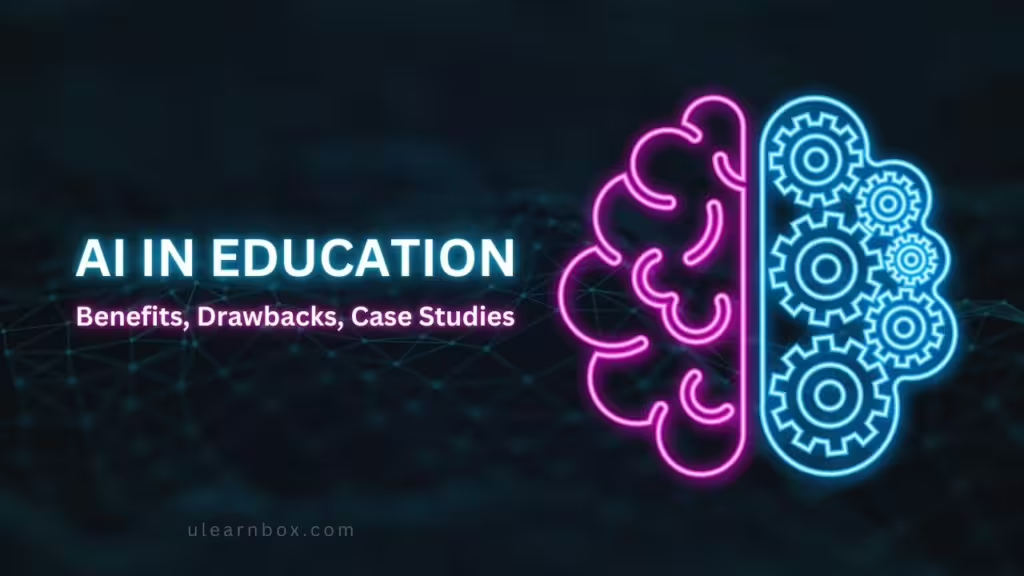
If you want to know more about AI’s definition and history, see the article overview of AI here.
Benefits of AI in Education
In terms of education, technology offers several significant advantages. Here are the common benefits of AI in education.
Personalized Learning
AI can craft individualized learning experiences that cater to each student’s unique needs. By analyzing student performance data, AI adjusts learning materials, pacing, and difficulty levels, ensuring customized educational content for every learner.
Provide Real-time Feedback
AI is capable of offering students immediate feedback on their work, lightening the load for teachers by delivering simultaneous guidance in classroom settings. This feedback helps students understand their strengths and weaknesses, allowing them to focus on areas for improvement in future lessons.
Access to Vast Educational Resources
AI unlocks access to a broad range of educational materials for both teachers and students, including images, videos, audio, and more. This wealth of resources enhances the learning experience and encourages self-directed learning.
Protect Student Data
AI serves as a digital safeguard, protecting student data and online activities from cyber threats. Not only does it secure student information, but it also ensures a safer online environment for educators and administrators alike.
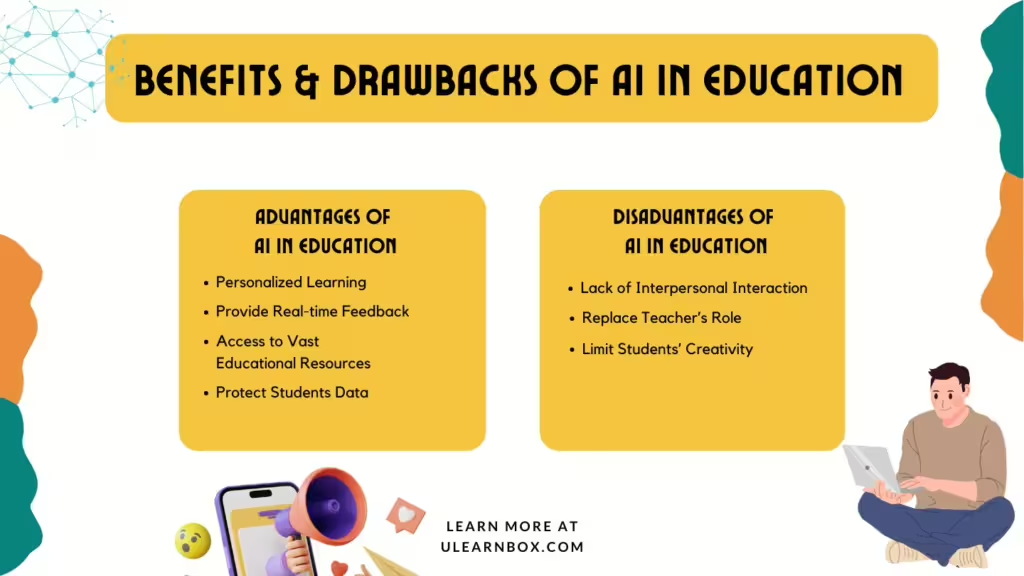
Drawbacks of AI in Education
While AI offers numerous educational advantages, it is essential to consider its drawbacks. Below are some of the challenges AI presents in education.
Lack of Interpersonal Interaction
Although technology significantly enhances the educational experience, relying solely on it can hinder students’ social communication skills and delay emotional intelligence (EQ) development. This reliance could contradict educational goals, highlighting the need for AI to complement, not replace, vital aspects of learning.
Replacing the Teacher’s Role
One key concern with the extensive use of AI in education is the potential for it to diminish the role of teachers. If AI can provide instant feedback, deliver vast resources, assess learning outcomes, and answer student questions, it raises the question: what is the teacher’s role now?
Limiting Students’ Creativity
In today’s environment, students can quickly turn to AI tools like ChatGPT or BingAI for answers, which, while convenient, can limit critical thinking. Overreliance on these tools may make students less inclined to think creatively or generate new ideas.
These are a few pros and cons of AI in education. In the next section, we’ll explore examples of AI in the educational field.
Example of Artificial Intelligence in Education
AI can benefit many aspects of education. Want to know more? We’ll examine actual instances of how AI is applied in educational settings.
Learning Language
Learning a new language has never been easy with AI-powered assistants. There are many language-learning applications in the market nowadays, you name it, Duolingo, ELSA, and so on. Thanks to AI algorithms, lessons are tailored to match individual performance as well as create amazing and unique personalized learning experiences for each student.
Create Online Quiz
Yes, you do not hear wrong! Artificial intelligence can help teachers create online quizzes for online exams or warm-up activities in class. The only thing you need to focus on is the question content, the apps will handle the layout and color to make the quiz slide appealing and attractive. You can experience Quizizz, Quizlet, or Kahoot to see if it addresses your concerns.
Create Presentation
AI empowers individuals to create compelling presentations with efficiency and innovation. Various online tools, such as uPresenter, rely on AI to help users refine content and create visually appealing slides. It not only saves time but also contributes to the creation of polished and professional presentations, highlighting the transformative impact of AI in the field of content creation.
As shown in the figure above, AI can assist both teachers and students to teach and study smarter and more effectively. Regarding learning language, there are many language-learning applications in the market nowadays, you name it, Duolingo, ELSA, and so on. You can also experience Quizizz, Quizlet, or Kahoot to create online quizzes. What’s more, various online tools, such as uPresenter, rely on AI to help users refine content and create visually appealing slides.
Final Words
In conclusion, integrating AI in education comes with both advantages and challenges. AI can enhance personalization and efficiency in learning, but there are concerns about job displacement and over-reliance on technology. However, the examples discussed demonstrate AI’s potential to reshape teaching and learning. Moving forward, it’s essential to strike a balance – leveraging AI’s benefits while being mindful of the obstacles it presents, ensuring we maximize its positive impact on education.
Follow us on Twitter to see more interesting information.
See more:
AI PowerPoint Presentation vs AI Slide Maker: Is it the Same?
Choosing the appropriate tool for creating presentations is essential, as it greatly influences the final result’s quality, efficiency, and impact. A good presentation tool simplifies the creative process, enabling users to concentrate on delivering clear, compelling content instead of wasting time on design adjustments. AI-powered solutions like AI PowerPoint Presentation provide smart design recommendations, real-time collaboration, and built-in accessibility options. Meanwhile, newer AI slide makers are becoming popular due to their ease of use and speed, making them feasible alternatives to replace AI PowerPoint presentations.

Table of contents:
- AI PPT presentation
- AI slide maker
- Comparison AI Powerpoint presentation vs AI slide maker
- Choose the right tool
Overview of AI PowerPoint Presentation
AI PowerPoint Presentation refers to the enhanced version of Microsoft PowerPoint that incorporates artificial intelligence to streamline the design and creation process. There are two AI-powered features in PPT, according to Microsoft.
One great AI feature in PowerPoint is its ability to recommend designs that fit your content. While it doesn’t create fully AI-generated slides, it gives you full control to customize and edit the presentation as needed. Another useful feature is the rehearsal tool, which monitors your speaking pace and provides feedback if you use filler words, helping you refine your delivery.
Currently, Microsoft has transformed the landscape with the introduction of CoPilot, their AI tool for Microsoft 365. Like many AI systems, CoPilot allows users to input a prompt and instantly generate a presentation. It can even create slides based on relevant information, condense lengthy content, and modify the design layout as needed. However, CoPilot is only available with paid access for creating presentations at present.
Overview of AI Slide Maker
AI Slide Maker refers to standalone, AI-powered tools designed to simplify creating presentations by automating much of the design work. An example like uPresenter allows users to generate professional-looking slides with minimal effort. These tools are known for their ease of use, providing pre-made templates designed by AI to ensure visual appeal. They also automate content formatting and layout, meaning users can focus on inputting their content while the tool handles the design. Additionally, AI slide makers can generate entire presentations from scratch based on minimal input, making them ideal for users who want fast, polished results without spending much time on design details.
A presentation created with uPresenter
Comparison of AI PowerPoint Presentation vs. AI Slide Maker
Both AI PPT presentation and AI slide maker have their true value. Here is a comparison highlighting AI PPT presentation vs. AI slide maker across various categories:
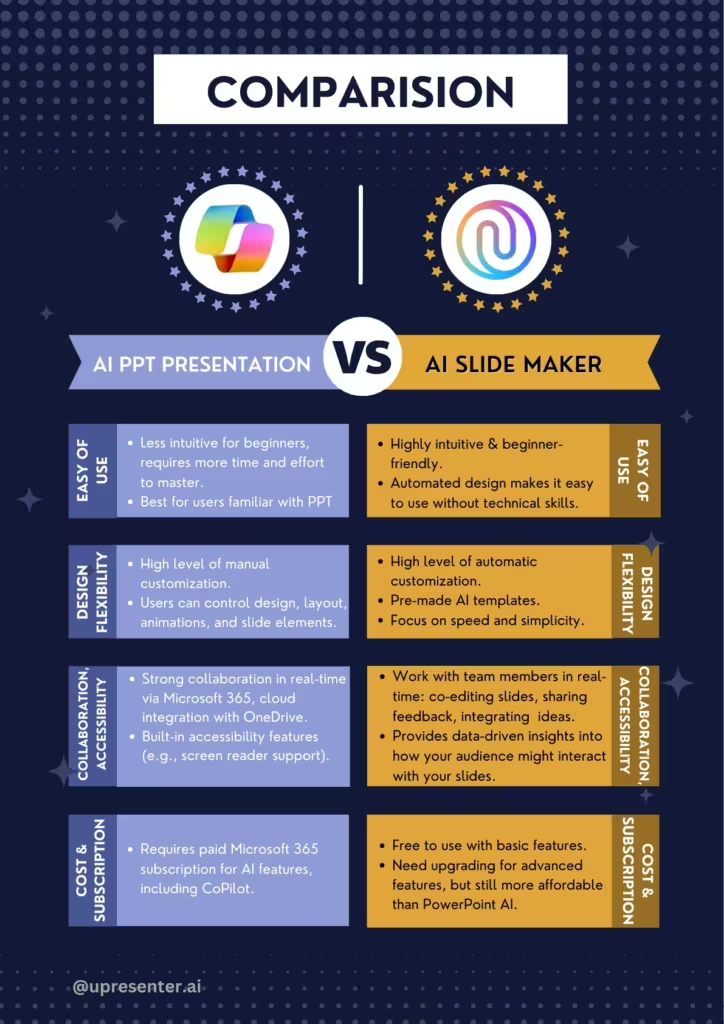
Which One is Your Best Choice?
When deciding between AI PowerPoint Presentation and AI Slide Maker, it’s important to consider your specific needs and the type of presentations you create. AI PowerPoint Presentation is ideal for professionals who require seamless integration with Microsoft tools, such as Word, Excel, and OneDrive, and who regularly collaborate on projects. This option is perfect for those needing advanced design assistance without sacrificing the flexibility to customize every detail. However, it comes at a higher cost, as the AI-powered CoPilot feature is only available with a paid Microsoft 365 subscription.
On the other hand, AI Slide Maker tools like uPresenter are best suited for users who want a quick, automated solution with minimal design effort. These tools are great for those new to creating slides or anyone looking for an easy-to-use, budget-friendly option. AI Slide Maker provides pre-made templates and automatically formats content, saving users time and effort. This simplicity is perfect for creating one-off presentations or for users who prioritize speed and ease of use over extensive design control. What’s more, some AI slide makers also generate interactive quizzes simultaneously with slide decks. Thanks to that, you got an interactive presentation in seconds. Not all AI Slide Makers have a quiz creation feature, but uPresenter does.
Last Words
In summary, AI Slide Maker is better for those seeking ease of use, rapid design, and a more affordable solution, especially for beginners. AI PowerPoint Presentation is the go-to choice for experienced users who need advanced flexibility, and integration with Microsoft’s ecosystem, but it comes with the added cost of a subscription. The decision is on you, just evaluate your needs and choose the right tool. Follow our Twitter/X page for more helpful and engaging information.
See more:
PowerPoint Alternative: Why Choose uPresenter Over PowerPoint?
Beautiful ai vs uPresenter: Feature & Pricing Comparison
Gamma Alternative: Choose This Tool Instead For AI-powered Presentation & Quiz
AI in eLearning: Which Tool Will Speed Up Your Process?
AI in eLearning is revolutionizing online education by making it more efficient and personalized. In this blog, we’ll explore the top AI tools that can enhance your eLearning development, streamline your workflow, and ultimately create a more effective learning experience for your students. Discover which tools are best suited to meet your needs and how they can propel your eLearning process forward.
Table of contents:
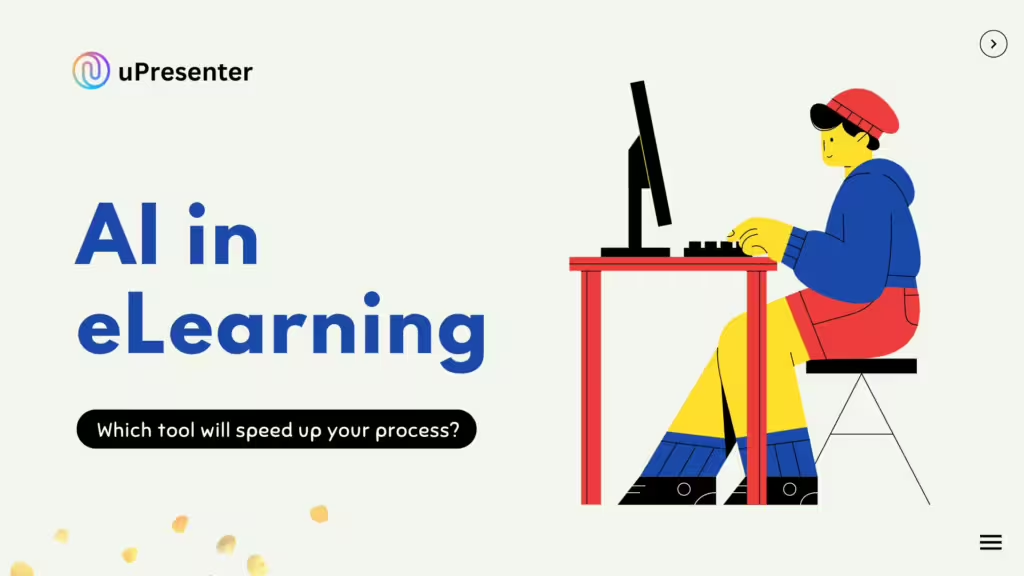
How has AI in eLearning Risen?
The evolution of eLearning began in the late 20th century with computer-based training and online courses. Initially focused on digitizing traditional materials, it evolved into more interactive, multimedia-rich experiences. The incorporation of AI marked a major shift, enabling personalized learning and adaptive paths with intelligent tutoring systems.
Today, AI-driven analytics monitor and predict student performance, while natural language processing enables interactive interfaces. Virtual and augmented reality create immersive learning environments, enhancing engagement and improving outcomes. These AI innovations are making education more accessible and efficient.
What are the Key AI Tools for eLearning?
Today, AI-powered tools have become essential components of eLearning. Let’s walk through some key types of AI tools in eLearning with us.
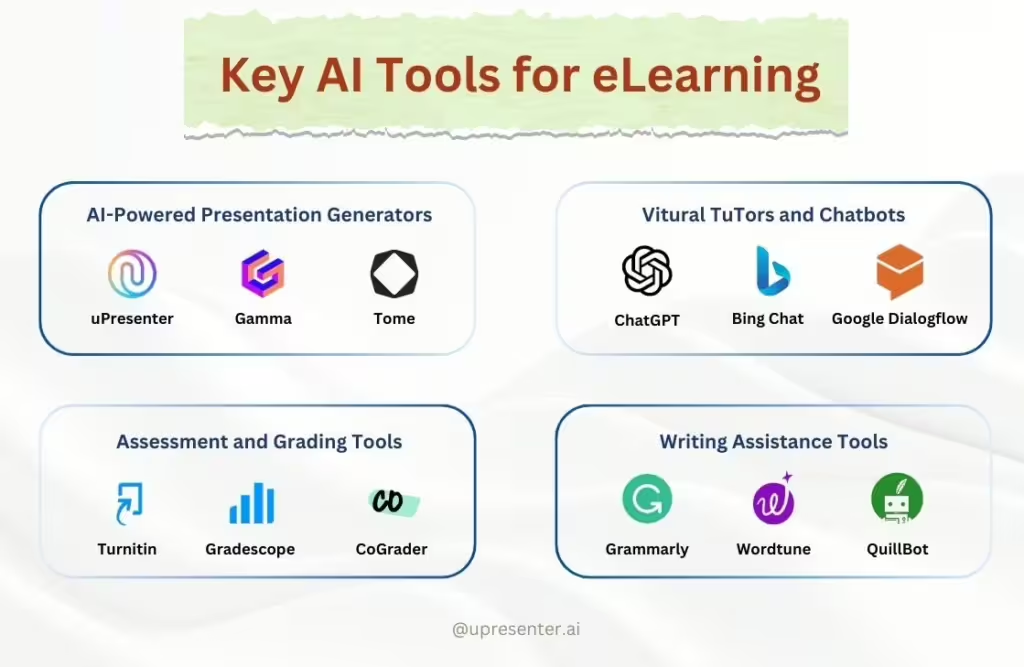
#1. Type 1: AI-Powered Presentation Generators
AI-powered presentation generators are revolutionizing the way eLearning content is created by automating and enhancing the process of building presentations. Specifically, these tools utilize artificial intelligence to streamline the creation of engaging and visually appealing slides. Thanks to that, educational content is not only informative but also captivating for learners.
Features: Automated content generation, real-time feedback, collaborative teamwork, etc.
Example Tools: uPresenter, Gamma, Tome, etc.
Feel free to try out uPresenter.
#2. Type 2: Vitural TuTors and Chatbots
AI tutors and chatbots play a crucial role in enhancing the eLearning experience by providing real-time assistance and support to learners. These AI-driven tools offer instant help and personalized guidance, making it easier for learners to access information, clarify doubts, and receive tailored support outside traditional classroom settings.
Features: 24/7 availability, instant feedback, personalized guidance, etc.
Example Tools: ChatGPT, BingChat, Google Dialogflow, etc.
#3. Type 3: Automated Assessment and Grading
Automated assessment and grading tools powered by AI are transforming eLearning by streamlining the evaluation process and providing instant feedback to learners. These tools not only save educators time but also enhance the learning experience by delivering personalized and accurate assessments.
Features: Instant grading, detailed feedback, and plagiarism detection, etc.
Example Tools: Turnitin, Gradescope, CoGrader, etc.
#4. Type 4: Writing Assistance
AI-powered writing assistance tools are revolutionizing eLearning by enhancing content creation with improved accuracy and efficiency. These tools help educators and learners alike by offering real-time grammar checks, style suggestions, and content optimization, making the learning process smoother and more effective.
Features: Real-time grammar and spelling checks, style and tone suggestions, content optimization, etc.
Example Tools: Grammarly, Wordtune, QuillBot, etc.
Take a look at Examples of AI in Education: Top 20+ Must-Know Tools for Educators for helpful information.
How to Choose the Right AI Tool for Your Needs?
Collectively, the AI tools in the list are not only reshaping eLearning content but also establishing new benchmarks for the creation and consumption of educational materials, enhancing the productivity, engagement, and accessibility of learning.
With a variety of AI tools available, choosing the right one to speed up your eLearning process can be daunting. Just take time to experience these AI tools and start integrating them into your eLearning development to enhance effectiveness. If you are looking for an amazing AI-powered presentation maker with the capability of generating quizzes, give uPresenter a try.

uPresenter is an AI-powered tool designed to revolutionize the way presentations are created. By leveraging advanced algorithms, it simplifies the process of designing and delivering professional presentations, making it accessible for users of all skill levels. Whether preparing a business pitch, educational material, or a creative project, uPresenter streamlines the workflow, allowing you to focus on the content. At the same time, the tool takes care of the design and structure. It’s an innovative solution that brings efficiency, creativity, and ease to the presentation creation process.
Final Words
In the fast-evolving world of education, leveraging technology has become crucial to stay ahead. AI has been a game-changer in eLearning, especially in recent years. AI-powered tools are revolutionizing the way we design, deliver, and experience online education, making it more personalized, efficient, and engaging. Hope that the blog provides you with interesting insights. Follow our Twitter/X page for regular updates.
See more:
- PowerPoint Alternative: Why Choose uPresenter Over PowerPoint?
- AI Presentation and Quiz Generator: Create eLearning Courses in Seconds
Overview of AI (Artificial Intelligence)
AI, or artificial intelligence, is a term we frequently hear, but what does it mean? In this blog, let’s grab an overview of AI with the definition, history, and its future impact.
There is no doubt that artificial intelligence (AI) is one of the hottest buzzwords in technology today. It is an ever-evolving force that is continuously reshaping our world in profound ways. This transformative technology has gotten into almost every facet of our lives, from the devices we use daily to the industries that power our economies. As we look to the future, AI has the potential to help solve big problems like climate change, and energy issues, use resources wisely, and make healthcare fair for everyone. The impact of AI on the world is a constantly evolving narrative. Its transformative potential knows no bounds, leaving us with a world that is continually and dynamically changed by its presence. Let’s dive deeper into the article for an overview of AI.
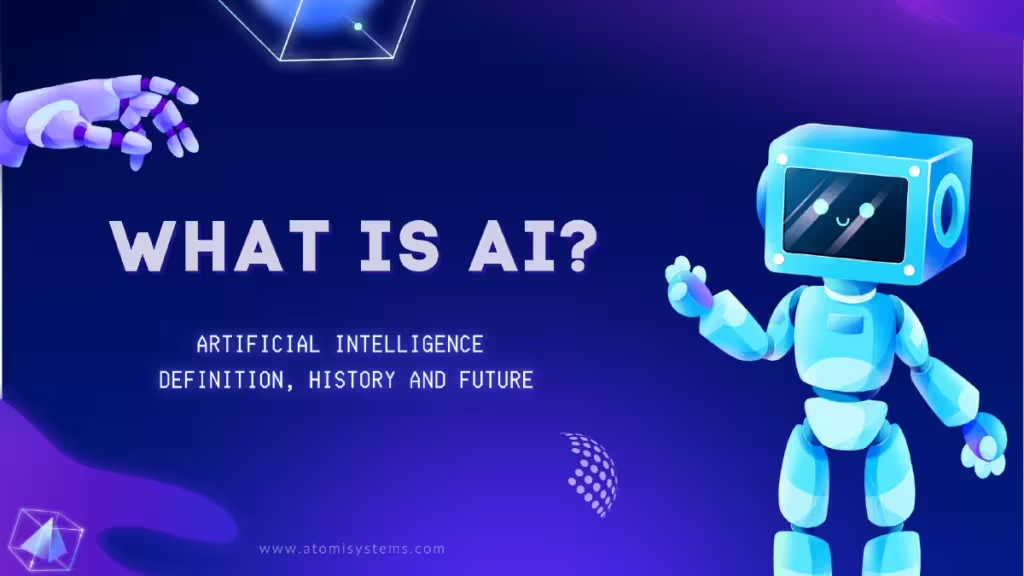
What is AI?
AI, which stands for Artificial Intelligence, is a branch of computer science that focuses on creating systems and machines capable of performing tasks that typically require human intelligence. These tasks include understanding natural language, recognizing patterns, solving complex problems, learning from experience, and making decisions.
How about AI History?
There has been a long development in AI history. The foundation for AI was laid in the early 1900s, with the most significant advancements not occurring until the 1950s. Right now, artificial intelligence is important in jobs like figuring out the order of RNA for vaccines and imitating how humans talk. These tasks rely a lot on computer programs and patterns, focusing on understanding, thinking, and generalizing. AI has become even more important with these new ideas, becoming a big deal like never before. It looks like it’s going to stay important in the future too.

We cannot mention robots, chatbots, driverless cars, Google Maps, etc, and yes, ChatGPT, and BingChat – the two AI-powered assistants that can interact and respond to almost all the question types. They are artificial intelligence products. In the next part of the article overview of AI, we’ll walk you through its impacts.
How Will AI Impact the Future?
As we can see, the current advancements in artificial intelligence are progressing exceptionally rapidly. The forthcoming era of AI holds boundless opportunities and practical applications that promise to streamline our daily lives significantly. As a result, it will positively impact humanity’s future. So, what will be the implications of artificial intelligence in the future? Let’s explore now!
AI in Education
AI in education is set to revolutionize the learning process for individuals of all ages. By leveraging machine learning, natural language processing, and facial recognition, AI facilitates the digitization of textbooks, identification of plagiarism, and assessment of students’ emotions. This helps identify those who may be struggling or disengaged. Presently and in the future, artificial intelligence customizes the learning experience to meet the unique needs of each student. The AI-powered presentation & quiz generators like uPresenter can save you tons of time and effort in creating learning content.

Additionally, what do you think about AI robot tutors? Yes, they can assist teachers and help enhance the educational experience and quality of learning.
AI in Healthcare
Scientists are studying how AI can help in medicine. artificial intelligence might make it easier for doctors to diagnose and treat illnesses early. It could also create new ways to treat problems like dementia and cancer. AI might even predict future illnesses by looking at a person’s health history and genes. This can help make plans to prevent problems before they happen.

While the roles of doctors, nurses, scientists, and others will remain indispensable, AI is expected to make our lives easier. It does this by making the information from doctors and health data more useful.
AI in Transportation
We heard about driverless cars or trains, so, what about driverless airplanes?

AI is opening in a transformative era for the transportation sector. Advances in artificial intelligence are shaping the present and future of transportation. They are especially influencing the groundbreaking development of applications for autonomous vehicles. As AI technologies mature, we anticipate a comprehensive redefinition of how transportation systems are conceived, designed, and operated. Artificial intelligence will have a big impact, making things like finding the best routes and managing traffic better. It will also improve safety features and how fuel is used, pushing the industry into a new era of efficiency, safety, and sustainability. Combining AI with transportation changes how things move around. It also opens up new ideas for clever, connected city spaces.
AI in Service Industry
The images of robots seamlessly taking over tasks typically handled by assistant staff in airports, cafes, or internal settings are not only visually striking but also hold the promise of enhanced efficiency. These automated entities not only demonstrate precision and effectiveness in their operations but also contribute to saving human energy. The potential impact goes beyond these initial settings, as the trajectory suggests an increasing substitution of human labor by robots and machines.

Looking forward, there is a possibility that customer service representatives, cashiers, and even cooks may be replaced by robots and machines driven by artificial intelligence. This transformative shift in the labor landscape prompts contemplation on the evolving role of automation in diverse sectors and the potential implications it carries for employment dynamics and human-machine collaboration.
AI in Cybersecurity
The increasing frequency of cybersecurity incidents in recent years has raised concerns among many corporate leaders. In response to this growing threat, artificial intelligence emerged as a strong ally in strengthening cybersecurity defenses. AI is crucial for detecting and preventing cyber threats by carefully analyzing network traffic, identifying anomalies, and predicting potential attacks. Its capabilities go beyond traditional methods, allowing for advanced threat detection and response mechanisms that greatly improve the overall security of systems and data. As businesses navigate the changing landscape of cyber threats, integrating artificial intelligence into cybersecurity strategies becomes a vital step in proactively protecting against a wide range of risks and vulnerabilities.

As such, the role of artificial intelligence is rapidly evolving, shaping various aspects of our lives and industries. From revolutionizing healthcare and transforming transportation to enhancing cybersecurity and simplifying daily tasks, AI’s impact is both profound and diverse.
Final Words
That’s an overview of AI. Begin with the question “What is AI”, then you walk through the history and the future of AI in our lives. As we look to the future, the potential applications of artificial intelligence seem boundless, promising unprecedented advancements in technology, efficiency, and problem-solving.

However, ethical considerations, responsible development, and thoughtful integration into society will be crucial to harnessing the full benefits of AI while navigating potential challenges. The journey into the future of AI holds exciting possibilities, encouraging us to embrace innovation responsibly and adapt to a world where the collaboration between humans and intelligent machines becomes increasingly knit.
See also:

